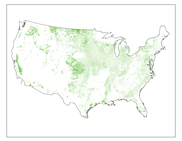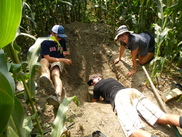|
Having trouble viewing this email? View it as a Web page.

|
|
|
Fresh From the Field is a weekly album showcasing transformative impacts made by partners supported by the National Institute of Food and Agriculture.
Editor: Falita Liles April 11, 2019
|
|
Success Stories

Incentivizing Feedstock Supply for the Bioeconomy
The emerging cellulosic biofuel and bioproduct industry requires the development of biomass markets where economic and policy challenges need to be overcome for farmers to engage as viable suppliers. Researchers at Auburn University and University of Illinois at Urbana-Champaign combined economic and ecological modeling to identify the economic barriers to biomass production, to evaluate the effectiveness of the Biomass Crop Assistance Program in stimulating the biomass market, and to explore the ecosystem service implications of biomass production. Early stage economic modeling shows that credit constraints and high interests can be major barriers to biomass production.
NIFA supports this research through the Agriculture and Food Research Initiative.
Read more about this bioeconomy project on NIFA’s Data Gateway.
|
News Coverage

Montana’s Schutter Diagnostic Laboratory Impacts Citizen’s Lives
Montana’s Schutter Diagnostic Laboratory is a critical component of extension outreach, and routinely processes over 2,000 samples per year for county extension, agricultural professionals, and citizens. The diagnostic lab is often the first place new pests in the state are identified. In 2017, first reports included the elm seed bug - Arocatus melanocephalus - from Ravalli County, damage to cabbage on a local foods farm by the invasive root weevil - Cathormiocerus spinosus - in Gallatin County, Fusarium root rot on chia and quinoa from Hill County, and Phoma stem blight on quinoa from Toole county. Researchers helped clients accurately identify plants to assess plant toxicity. For example, several elk died after eating an ornamental shrub identified as ornamental yew (Taxus x media), a shrub that has been implicated in wildlife losses in Idaho residential areas. Through the proper identification of an invasive weed Crepis tectorum – narrowleaf hawksbeard –Schutter Laboratory helped growers reduce populations and conserve crop yield. Growers have changed management practices, increased scouting, and have saved over $6 million in Valley County and over $200 million in the MonDak area due to crop yield losses that would have been incurred from this weed.
NIFA supports this work with funding from the Crop Protection and Pest Management Program.
To learn more about Montana’s Extension IPM project, please visit the project page at NIFA’s Data Gateway.
|
Library

Increasing Ecosystem Services and Climate Change Resilience in Dominant Agroecosystems of the Northeast
Climate change is demanding that we find new ways to adapt agricultural systems to remain profitable, curb environmental impacts, and minimize their contributions to greenhouse gas emissions. The University of Vermont Extension is working with farmers to understand how different practices on northeastern dairy farms can help build resilience to weather extremes in a changing climate. By comparing conventional and alternative management practices on dominant agricultural land use in Vermont (i.e., corn silage and hay), researchers will gain a better understanding of how a shift in cropping management will affect water quality, field and watershed hydrology, and adaptation and mitigation of climate change.
NIFA supports the research through the Agriculture and Food Research Initiative.
Contact: Joshua Faulkner (joshua.faulkner@uvm.edu)
|
Tweet of the Week
#NIFAIMPACTS

|
|

NIFA’s mission is to invest in and advance agricultural research, education, and extension that solve societal challenges. NIFA’s investments in transformative science directly support the long-term prosperity and global preeminence of U.S. agriculture. To learn more about NIFA’s impact on agricultural sciences, visit www.nifa.usda.gov/Impacts, sign up for email updates or follow us on Twitter @USDA_NIFA, #NIFAImpacts.
USDA is an equal opportunity lender, provider, and employer.
|
|